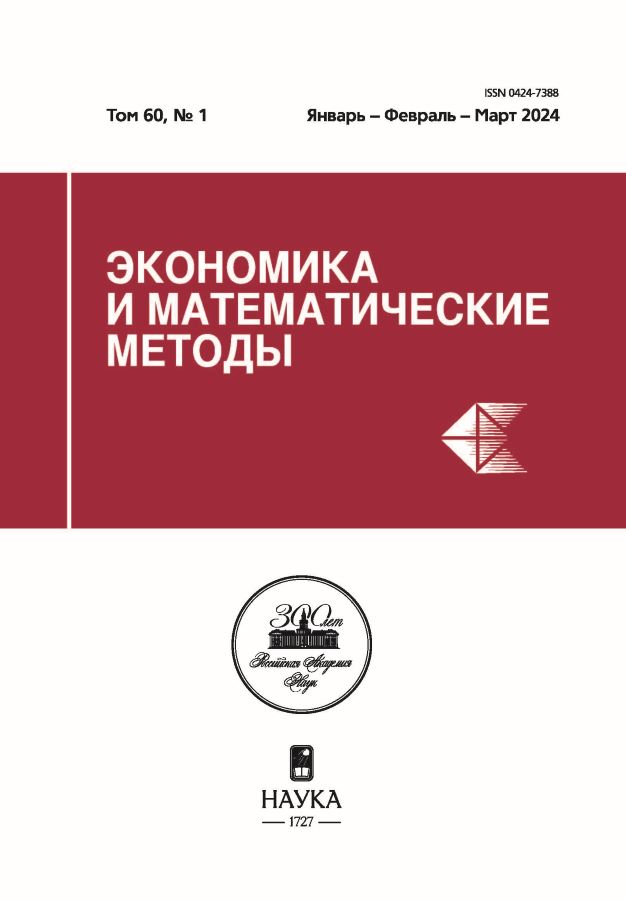Survival of the strongest in a sequential truel
- Authors: Ilinskiy D.G.1,2, Izmalkov S.B.3, Savvateev A.V.4,5,6
-
Affiliations:
- Central Economics and Mathematics Institute RAS
- Institute of Physics and Technology
- New Economic School
- Caucasus Mathematical Center, Adyghe State University
- Moscow Institute of Physics and Technology
- Central Economics and Mathematics Institute, RAS
- Issue: Vol 60, No 1 (2024)
- Pages: 133-140
- Section: Mathematical analysis of economic models
- URL: https://rjpbr.com/0424-7388/article/view/653318
- DOI: https://doi.org/10.31857/S0424738824010111
- ID: 653318
Cite item
Abstract
Sequential truel is a duel-like game between three players. Each players is endowed with his own marksmanship. At each turn, a player whose turn is to shoot can target any of the remaining alive opponents or abstain from shooting. The game ends when there is only one player alive or when all alive players abstained from shooting one after another. The single survivor obtains the “survivor” prize 1, while the payoff of all other players is 0. In the case the truel ends due to “inactivity”, all the players receive the payoff of 0. It is a deeply studied game with paradoxical finding that the weakest player has the highest probability of surviving in many settings, especially when the player can abstain from shooting. Here we present an explicit construction that contradicts this finding. There exists a mixed strategy subgame perfect equilibrium in which the strongest player has the highest probability of survival. This equilibrium exists for a specific order of play, in which the two stronger opponents act before the weakest one. When it exists, there are multiple subgame-perfect equilibria, including the existing stationary construction, in which two stronger opponents target each other.
Full Text
About the authors
D. G. Ilinskiy
Central Economics and Mathematics Institute RAS; Institute of Physics and Technology
Author for correspondence.
Email: nograhol@gmail.com
Russian Federation, Moscow; Dolgoprudny
S. B. Izmalkov
New Economic School
Email: sizmalkov@nes.ru
Russian Federation, Moscow
A. V. Savvateev
Caucasus Mathematical Center, Adyghe State University; Moscow Institute of Physics and Technology; Central Economics and Mathematics Institute, RAS
Email: hibiny@mail.ru
Russian Federation, Maikop; Dolgoprudny; Moscow
References
- Amengual P., Toral R. (2006). Truels, or the survival of the weakest. Computing in Science and Engineering, 8 (5), 88–95.
- Archetti M. (2012). Survival of the weakest in n-person duels and the maintenance of variation under constant selection. Evolution: International Journal of Organic Evolution, 66 (3), 637–650.
- Bossert W., Brams S. J., Kilgour D. M. (2002). Cooperative vs non-cooperative truels: Little agreement, but does that matter? Games and Economic Behavior, 40 (2), 185–202.
- Cole S. G., Phillips J. L., Hartman E. A. (1977). Test of a model of decision processes in an intense conflict situation. Behavioral Science, 22 (3), 186–196.
- Dubovik A., Parakhonyak A. (2014). Drugs, guns, and targeted competition. Games and Economic Behavior, 87, 497–507.
- Gardner M. (1966). More mathematical puzzles and diversions. London: Penguin.
- Kilgour D. M. (1972). The simultaneous truel. International Journal of Game Theory, 1 (5), 229–242.
- Kilgour D. M. (1975). The sequential truel. International Journal of Game Theory, 4 (3), 151–174.
- Kilgour D. M. (1978). Equilibrium points of infinite sequential truels. International Journal of Game Theory, 6 (3), 167–180.
- Kilgour D. M., Brams S. J. (1997). The truel. Mathematics Magazine, 70 (5), 315–326.
- Kinnaird C. (1946). Encyclopedia of puzzles and pastimes. N.Y.: Citadel Press.
- Mosteller F. (1987). Fifty challenging problems in probability with solutions. Reading: Addison-Wesley Publishing Co.
- Phillips H. (1937). Question time: An omnibus of problems for a brainy day. London: J. M. Dent & Sons.
- Richman J. T. (2020). Victory by the weakest: Effects of negative advertising in N > 2 candidate campaigns. Virginia Social Science Journal, 54, 30–39.
- Shubik M. (1954). Readings in game theory and related behavior. Chapter: Does the fittest necessarily survive? N.Y.: Doubleday, Garden City.
- Shubik M. (1964). Game theory and related approaches to social behavior selections. N.Y.: John Wiley & Sons.
- Skaperdas S., Grofman B. (1995). Modeling negative campaigning. American Political Science Review, 89 (1), 49–61.
- Toral R., Amengual P. (2005). Distribution of winners in truel games. In: AIP Conference Proceedings, 779, 128–141. College Park (MD): American Institute of Physics.
- Wegener M., Mutlu E. (2021). The good, the bad, the well-connected. International Journal of Game Theory, 50 (3), 759–771.
Supplementary files











